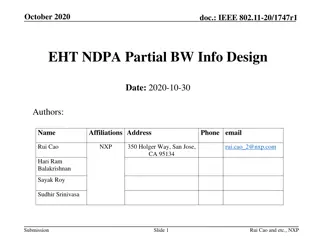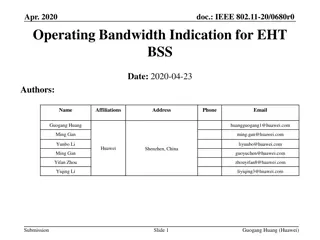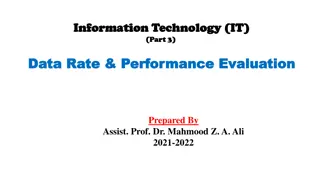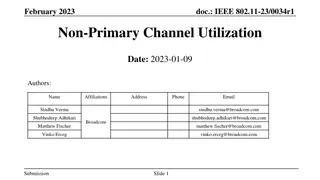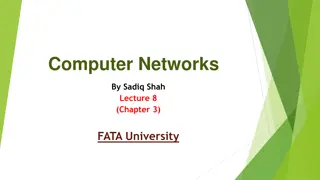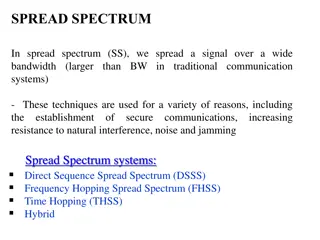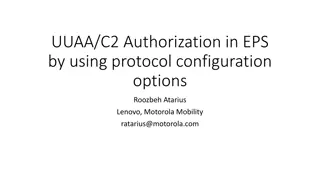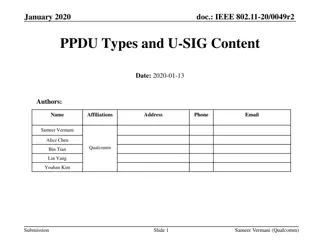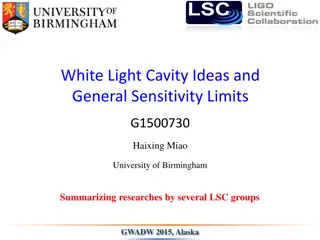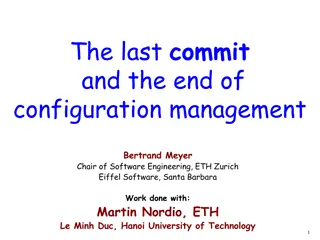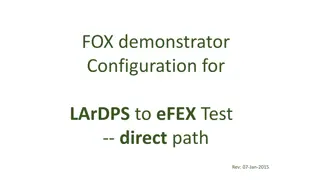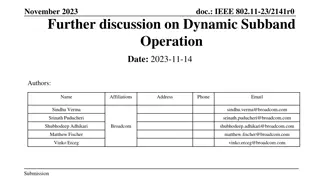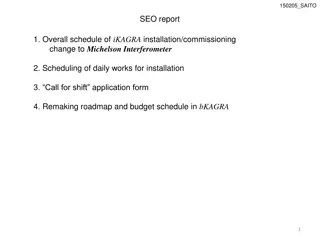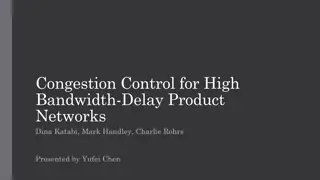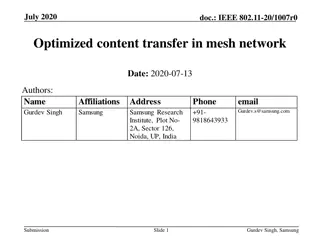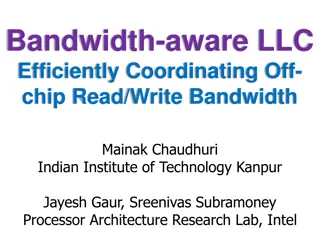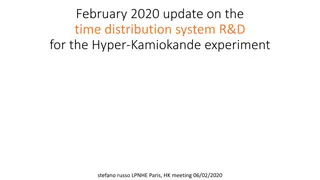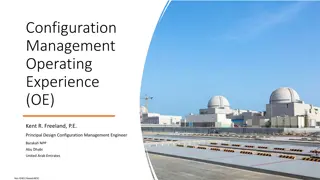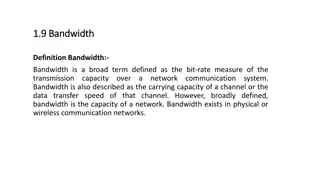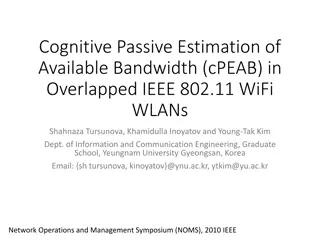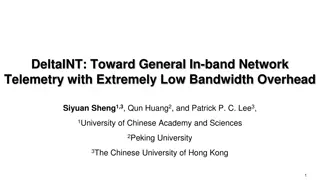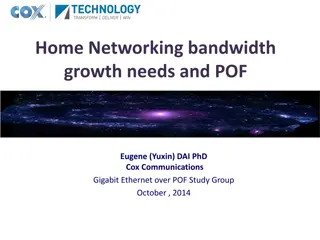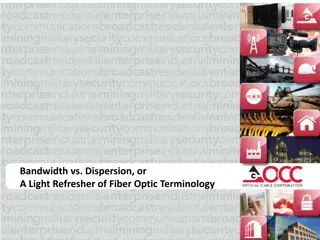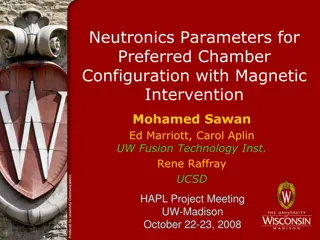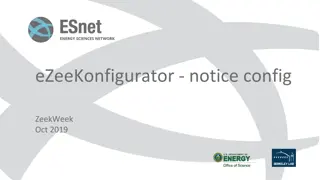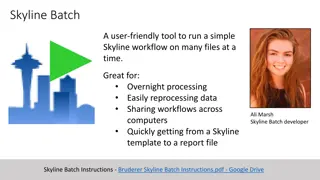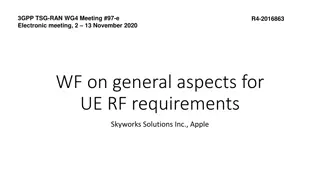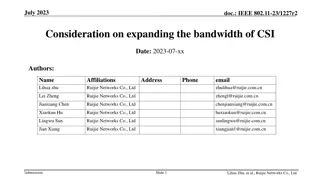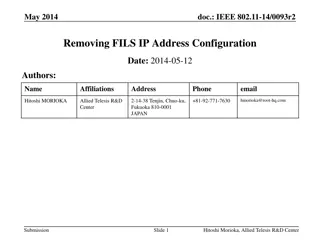IEEE 802.11-23/1288r0 Bandwidth Utilization Proposal
This proposal aims to improve bandwidth utilization in IEEE 802.11 networks by allowing devices to transmit on idle channels within the operating bandwidth. It addresses the inefficiencies caused by the current limitation where devices do not transmit on idle portions if the primary channel is busy.
2 views • 24 slides
WHONET Training Course: Laboratory Configuration and Setup
Understanding the laboratory configuration process in WHONET is crucial for effective data entry and analysis. This module guides users on setting up a new laboratory, entering country and lab details, defining antibiotics, sample locations, and data fields, creating microbiological alerts, and savi
3 views • 57 slides
Challenges and Requirements for Bandwidth Indication in IEEE 802.11
The document discusses challenges and requirements related to bandwidth indication in RTS/CTS frames with PPDU in 320 MHz, focusing on scenarios where bandwidth signaling may lead to misinterpretation by stations. It highlights the need for dynamic bandwidth and preamble puncturing information in RT
3 views • 21 slides
Design Considerations for Partial Bandwidth Information in IEEE 802.11-20/1747r1
Design considerations for partial bandwidth information in the IEEE 802.11-20/1747r1 standard are discussed, focusing on EHT NDPA frame structure, feedback mechanisms, bitmap design, and table-based designs to support large RU/MRUs. The feedback mechanism utilizes bitmap resolution signals, providin
1 views • 10 slides
Bandwidth Indication for EHT BSS in IEEE 802.11-20/0680r0
This IEEE document discusses the proposal to use an Enhanced High Throughput (EHT) operation element to indicate operating bandwidth for EHT Basic Service Sets (BSS). It suggests methods for indicating channel configurations, punctured channels, and channel width for EHT stations. The goal is to ena
0 views • 15 slides
Understanding Data Rate Limits in Data Communications
Data rate limits in data communications are crucial for determining how fast data can be transmitted over a channel. Factors such as available bandwidth, signal levels, and channel quality influence data rate. Nyquist and Shannon's theoretical formulas help calculate data rate for noiseless and nois
0 views • 4 slides
Proposal for Efficient Bandwidth Utilization in IEEE 802.11 Networks
This proposal aims to address the inefficient utilization of bandwidth in IEEE 802.11 networks by allowing stations to transmit on idle channels within their operating bandwidth. The document discusses the problem statement, high-level solution, relevant capabilities of transmitters and receivers, p
0 views • 15 slides
Understanding Bandwidth and Digital Signals in Computer Networks
Exploring the concept of bandwidth in computer networks, which refers to the range of frequencies in a signal, and delving into the decomposition of signals into simple sine waves using tools. Additionally, the discussion covers digital signals, their representation, and the transmission of informat
1 views • 14 slides
Understanding Spread Spectrum Communication Systems
Spread spectrum techniques involve spreading a signal over a wide bandwidth for various reasons, such as secure communication, resistance to interference, noise, and jamming. This summary introduces Direct Sequence Spread Spectrum (DSSS), Frequency Hopping Spread Spectrum (FHSS), Time Hopping, and h
0 views • 25 slides
Enhancing EPS Authorization and Configuration Options in 5G Networks
The proposal focuses on enhancing authorization and configuration options in EPS using protocol configuration options. It discusses the attach procedure, ePCO checking, and the importance of ePCO support in the network architecture. The solution presented emphasizes the role of MME, SGW, and PGW-C+S
0 views • 8 slides
IEEE 802.11 Proposal for 320MHz Ranging Enhancement
This document discusses the proposal for enhancing IEEE 802.11 with support for 320MHz bandwidth ranging operations. It aims to improve ranging accuracy by expanding 802.11az frames and procedures to accommodate the increased bandwidth. The focus is on MAC-related changes, exploring different option
2 views • 26 slides
Understanding Performance Analysis of Digital Modulation Techniques
Explore the realm of digital modulation techniques such as ASK, FSK, PSK, QPSK, QAM, and more. Learn about bandwidth efficiency, baud rates, minimum bandwidth, and how to calculate them. Discover the importance of M-ary modulation and how it impacts data transmission rates and bandwidth requirements
4 views • 18 slides
IEEE 802.11-20/0049r2: PPDU Types and Bandwidth Information Update
These slides discuss the inclusion of bandwidth information in U-SIG fields for IEEE 802.11 networks. The focus is on enhancing spectrum occupancy details in a version-independent manner, allowing for future-proofing with potential higher bandwidths. Suggestions include incorporating a PPDU type fie
0 views • 24 slides
Advances in White Light Cavity for Sensitivity and Bandwidth Optimization
The research discusses innovative ideas for enhancing sensitivity and bandwidth limits in the context of white light cavity technologies. It explores methods such as external/internal squeezing and signal recycling to surpass existing Mizuno Limits, shedding light on crucial issues for future upgrad
0 views • 27 slides
Enhancing Memory Cache Efficiency with DRAM Compression Techniques
Explore the challenges faced by Moore's Law in relation to bandwidth limitations and the innovative solutions such as 3D-DRAM caches and compressed memory systems. Discover how compressing DRAM caches can improve bandwidth and capacity, leading to enhanced performance in memory-intensive application
0 views • 48 slides
Evolution of Configuration Management in Software Engineering
Explore the evolution of configuration management in software engineering, highlighting key practices like cloud-based IDE, shared repositories, and unobtrusive configuration management. Understand the importance of modern best practices in software development, traditional vs. optimistic approaches
0 views • 20 slides
Enhancing Support for Wider Bandwidth OFDMA in IEEE 802.11 Networks
The document discusses the implementation of Selective Spatial Transmission (SST) and Dynamic Subband Operation (DSO) to enable wider bandwidth OFDMA in IEEE 802.11be and 802.11bn standards. It covers enhancements for 80MHz, 160MHz, and 320MHz EHT DL and UL OFDMA transmissions, emphasizing the benef
0 views • 18 slides
LArDPS to eFEX Test Configuration for FOX Demonstrator
Configuration details and diagrams for testing the direct path from the LArDPS to eFEX in the FOX Demonstrator, including optical insertion loss measurements, offset calibration using different setups, and diagrams without splitters. The setup matches the planned configuration for the test.
0 views • 34 slides
IEEE 802.11-23/2141r0 Dynamic Subband Operation Discussion
Discussion on Dynamic Subband Operation in IEEE 802.11-23/2141r0 focusing on enabling flexible bandwidth allocation between APs and non-APs for improved resource utilization and system performance. The proposal aims to address bandwidth mismatches and enhance efficiency in channel access allocation
0 views • 15 slides
Bandwidth and Packet Type Detection Schemes for 40-50GHz Millimeter Wave Communication Systems
The document discusses bandwidth and packet type detection schemes for 40-50GHz millimeter wave communication systems in IEEE 802.11aj specifications. It proposes a preamble design for auto-detection of bandwidth and packet type to improve channel estimation and decoding efficiency. By utilizing dif
0 views • 27 slides
Updates on iKAGRA Installation and Configuration Changes
The report discusses changes in the iKAGRA configuration from Fabry-Perot Michelson Interferometer to Michelson Interferometer due to schedule constraints and budget limitations. The document outlines the revised schedule for installation tasks, shift applications, and the impact on the KAGRA projec
0 views • 16 slides
Congestion Control for High Bandwidth-Delay Product Networks
This presentation discusses the challenges faced by TCP in high bandwidth-delay product networks, highlighting issues such as oscillations and instability. It explores solutions like adjusting aggressiveness based on feedback delay, decoupling efficiency and fairness control, and introduces XCP as a
0 views • 23 slides
Optimized Content Transfer in Mesh Networks Using Bandwidth-Aware Chunking
This presentation by Gurdev Singh from Samsung addresses a technique for optimized content transfer in mesh networks by splitting content into file chunks based on the bandwidth of the channel. By considering the bandwidth or link quality of destination nodes, the content is divided so that lower ba
0 views • 20 slides
Enhancing Off-chip Bandwidth Utilization for Improved System Performance
Efficiently coordinating off-chip read/write bandwidth through the Bandwidth-aware LLC proposal yields a 12% performance improvement in an 8-core system across multiple workloads. This approach optimizes DRAM read latency, surpassing existing policies and filling performance gaps while confirming lo
1 views • 36 slides
Time Distribution System R&D Update for Hyper-Kamiokande Experiment
In the February 2020 update, Stefano Russo from LPNHE Paris presented the progress on the time distribution system R&D for the Hyper-Kamiokande experiment. The focus is on implementing a bidirectional data exchange link with a large bandwidth capacity for synchronous, phase-deterministic protocol. T
0 views • 17 slides
Insights into Operating Experience and Configuration Management in Nuclear Power Plants
Explore the significance of Operating Experience (OE) in refining machine and human performance, reinforcing desired behaviors, solving problems timely, and sharing industry-wide knowledge in nuclear power. Learn from examples highlighting the importance of configuration management in mature nuclear
0 views • 11 slides
Understanding Bandwidth, Channel Capacity, and Noise in Communication Networks
Bandwidth is a crucial aspect of network capacity, describing the data transfer speed and carrying capacity of a channel. Channel capacity involves factors like data rate, bandwidth, noise, and error rate. Noise sources include thermal noise, impulse noise, and delay distortion, impacting signal qua
0 views • 5 slides
Cognitive Passive Estimation of Available Bandwidth in Overlapped IEEE 802.11 WiFi WLANs
Efficient bandwidth estimation is crucial for network management and QoS applications, with cognitive passive methods offering insights without additional traffic loads. This research explores the impact of control messaging overhead, network topology, channel usage, hidden/exposed terminals, and pa
0 views • 13 slides
DeltaINT: General In-band Network Telemetry with Low Bandwidth Overhead
This paper discusses DeltaINT, a novel framework for in-band network telemetry aimed at reducing bandwidth overhead while ensuring high generality and convergence. It addresses the limitations of existing methods by providing theoretical analysis on bandwidth mitigation guarantees and offering softw
0 views • 20 slides
Meeting Home Networking Bandwidth Needs with GEPOF Technology
Gigabit Ethernet over Polymer Optical Fiber (GEPOF) is a promising technology addressing the growing bandwidth requirements in home networking. Advances in FTTH technology enable high-speed connections for Smart Homes, supporting services like cloud computing, 4K video streaming, and Internet of Thi
0 views • 15 slides
Intelligent DRAM Cache Strategies for Bandwidth Optimization
Efficiently managing DRAM caches is crucial due to increasing memory demands and bandwidth limitations. Strategies like using DRAM as a cache, architectural considerations for large DRAM caches, and understanding replacement policies are explored in this study to enhance memory bandwidth and capacit
0 views • 23 slides
Understanding Bandwidth and Dispersion in Fiber Optic Communication
This presentation provides a comprehensive overview of bandwidth and dispersion in fiber optic communication. It covers essential terminologies like microns, nanometers, millimeters, and dB, explaining concepts such as bandwidth capacity, dispersion cancellation, and modal bandwidth in multimode fib
0 views • 24 slides
Evolution of Communication Systems: From Bandwidth Division to Spread Spectrum
Third-generation communication systems utilize Pseudo-Noise (PN) codes to share bandwidth without interference, while first and second-generation systems divide bandwidth into smaller channels. PN codes are vectors with 1s and -1s, orthogonal to each other. Users transmit data using PN coding, combi
0 views • 14 slides
Advanced Neutronics Parameters for Fusion Chamber Configuration with Magnetic Intervention
Detailed analysis and design considerations for a fusion chamber configuration utilizing magnetic intervention to optimize neutronics parameters. The discussion includes blanket configuration, neutron wall loading distribution, blanket design options, nuclear design requirements, and dimensions meet
0 views • 12 slides
Recap of eZeeKonfigurator Notice Configuration and Zeek Week Oct 2019
A summary of events involving a talk at Zeek Week, issues with notice configuration, experiences with Zeek/Bro, and the introduction of eZeeKonfigurator for configuring Zeek clusters. The content includes descriptions of individuals involved, challenges faced, support for cluster configurations, and
0 views • 20 slides
Efficient Skyline Batch Workflow Tool for Processing Multiple Files
Utilize Skyline Batch, a user-friendly tool developed by Ali Marsh, to run simple Skyline workflows on multiple files efficiently. This tool is ideal for overnight processing, reprocessing data easily, and sharing workflows across different computers. Quickly transform Skyline templates into report
0 views • 4 slides
Overview of UE RF Requirements for 35/45MHz Channel Bandwidth in 3GPP Meeting #97-e
The document discusses the introduction of 35/45MHz channel bandwidth in UE RF requirements for various bands. It covers equation-based requirements and limitations in UL configurations based on bandwidth allocation. The scope includes capturing content from the first round discussions and clarifyin
0 views • 16 slides
Enhancing Bandwidth of Channel State Information (CSI) for Wireless Sensing Applications
This submission delves into the necessity of expanding the bandwidth of Channel State Information (CSI) in wireless environments to cater to the demands of time-sensitive wireless sensing applications. It explores the implications of high-bandwidth CSI on enhancing wireless channel understanding, ac
0 views • 12 slides
Removal of FILS IP Address Configuration in IEEE 802.11-14/0093r2
This document details the rationale behind the proposal to remove FILS IP Address Configuration in IEEE 802.11-14/0093r2. The author, Hitoshi Morioka, explains that the need for this configuration is redundant due to the HLP encapsulation's ability to support all required functions. By eliminating c
0 views • 18 slides
Enhancing Memory Bandwidth with Transparent Memory Compression
This research focuses on enabling transparent memory compression for commodity memory systems to address the growing demand for memory bandwidth. By implementing hardware compression without relying on operating system support, the goal is to optimize memory capacity and bandwidth efficiently. The a
0 views • 34 slides



